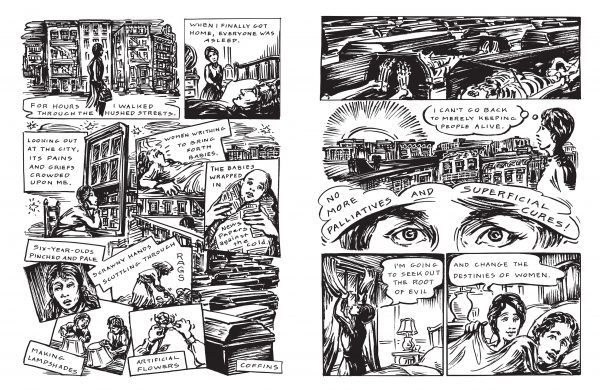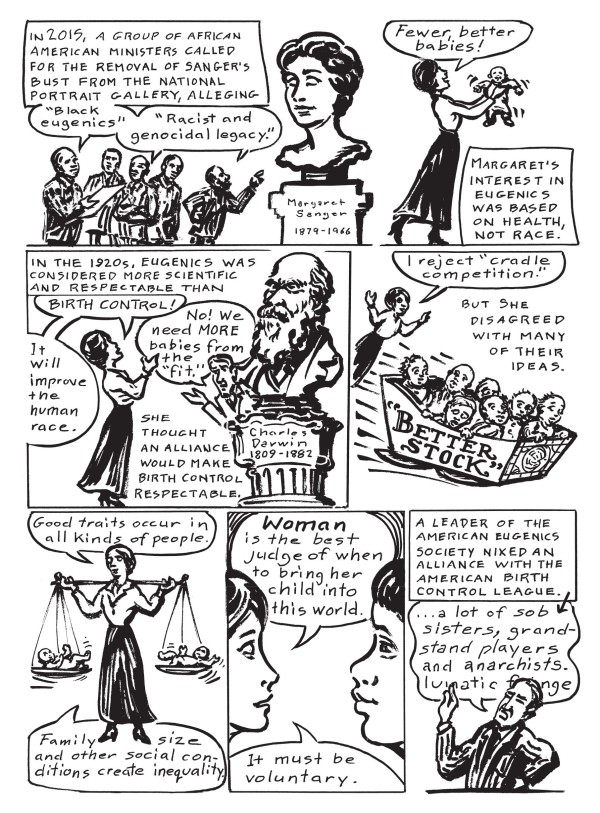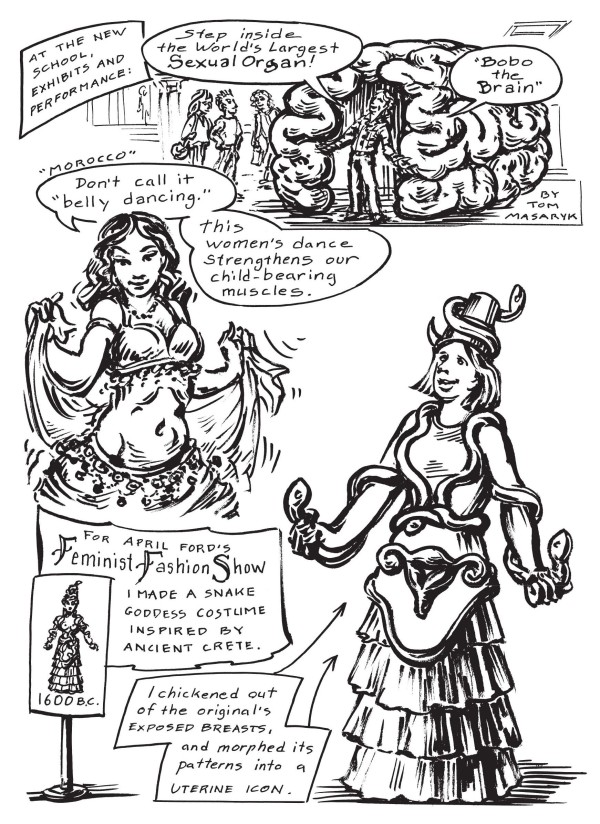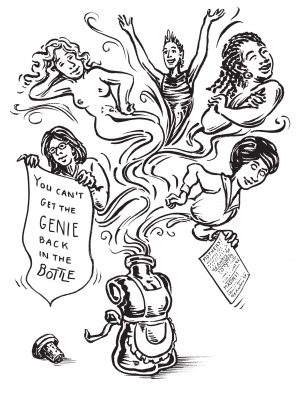
This post was produced in partnership with Bloom, a literary site that features authors whose first books were published when they were 40 or older.
1.
“Birth control is the first important step woman must take toward the goal of her freedom. It is the first step she must take to be man’s equal. It is the first step they must both take toward human emancipation.” — Margaret Sanger
When I went away to college, I made two trips off campus almost as soon as I had dumped my suitcase on my dorm room bed. One was to find the nearest bookstore, where I applied for a job. The other was to find the nearest health clinic where I could get a prescription for the Pill. Both were a success.
Young, arrogant, and excited for the future, I took the clinic trip completely for granted. I never questioned my right to that birth control prescription, with or without parental approval, my right to be sexually active, my right to decide when or if I would be willing to get pregnant. Birth control was a thing you did if you were a girl. It was preventative. Like vaccinations.
Looking back, now, I realize I was lucky — certainly to have a family that talked about sex in terms of health instead of morality, but mostly to have come of age at a time when birth control was easily obtained, relatively safe, and reliable. I never thought about it, with my feet up in those stirrups, but my mother didn’t have the benefits of birth control that I did. The Pill had only received FDA approval about 25 years before I decided to lie back on that table. And it took 12 more years to legalize it in every state. So when I walked into that clinic, I was actually part of a brave new world for women everywhere. I wish I had known it.
2.
 Unlike me, the artist and writer Sabrina Jones did know it. As she explains in the early pages of her recent graphic novel, Our Lady of Birth Control: A Cartoonist’s Encounter with Margaret Sanger, her sexual education seems to have begun when “an interesting book appeared at my house.” Jones immediately snuck up to her room to read Our Bodies, Ourselves, which was, and is, the most influential and frankly practical book ever to be written on the topic of women’s health, and one that had the added benefit of being entirely guilt- and shame-free.
Unlike me, the artist and writer Sabrina Jones did know it. As she explains in the early pages of her recent graphic novel, Our Lady of Birth Control: A Cartoonist’s Encounter with Margaret Sanger, her sexual education seems to have begun when “an interesting book appeared at my house.” Jones immediately snuck up to her room to read Our Bodies, Ourselves, which was, and is, the most influential and frankly practical book ever to be written on the topic of women’s health, and one that had the added benefit of being entirely guilt- and shame-free.
That book was the beginning of Jones’s own sexual awakening, a journey that eventually led her to the spot that once housed America’s first birth control clinic — an unremarkable building on an unremarkable street in Brooklyn, N.Y. There was nothing significant about the place, except that one day, 100 years earlier, a woman set up a clinic to hand out information about birth control to the neighborhood’s mostly working-class and immigrant population, and was promptly arrested for obscenity and being a public nuisance.
Obscenity. Public Nuisance. Phrases that seem to attach themselves to every feminist who dares to raise her voice. And no one was more daring than Margaret Sanger. “There ought to be a plaque,” thought Jones, standing on that Brooklyn street a century later. But there wasn’t a plaque, so Jones — a cartoonist and scenic artist — went home and wrote Our Lady of Birth Control.
“Sabrina Jones,” according to RoGallery’s biography, “has been writing and illustrating comics since the Reagan era.” That is, she came of age at a time when the backlash to second-wave feminism was gaining momentum, and when the threat of HIV loomed over every sexual encounter. Alarmed by the political climate, Jones — a graduate of Pratt Institute in New York — joined a group of activist artists, Carnival Knowledge, focusing her energies on feminism and social justice. She helped found GirlTalk, a comic about the things women feel safe to say to each other when there aren’t men in the room: “Do we really speak ‘In a Different Voice,’ as Carol Gilligan posits,” Jones asks in her introduction to issue #1, “our speech crimped and curled since elementary school? When men talk, it’s history, when we do, it’s coffee klatch, chitchat, gossip, nagging, shrill, old wives tales — sorry, I’m ranting.”
 Jones would also go one to create comics for The Real Cost of Prisons Project, highlighting the disparity between the fates of black and white people in the justice system and the damages of the “War on Drugs.” In 2008, Jones wrote her first full-length graphic biography, Isadora Duncan, about the acclaimed dancer, who defied social expectations. (“100 years ago,” it begins, “Americans liked their statues loosely draped and their daughters laced up tight.”)
Jones would also go one to create comics for The Real Cost of Prisons Project, highlighting the disparity between the fates of black and white people in the justice system and the damages of the “War on Drugs.” In 2008, Jones wrote her first full-length graphic biography, Isadora Duncan, about the acclaimed dancer, who defied social expectations. (“100 years ago,” it begins, “Americans liked their statues loosely draped and their daughters laced up tight.”)
Our Lady of Birth Control, published last July by Soft Skull Press, is the artist’s tribute to a woman who has affected women’s quality of life possibly more than any other single person; it is also a kind of extended argument for Sanger’s relevancy today. The social attitudes about women she wanted to change, the rights and opportunities she fought so hard for — these are all issues that are still on the front lines today, something Jones brings to the fore by interspersing throughout the story of Sanger’s life chapters on her own sexual awakening, and the contemporary politics of women’s reproductive rights. Panels showing demonstrations in 1916 are followed by Jones’s account of guiding women to the doors of a barricaded clinic while anti-abortion activists hurled insults at them. Pages on the history of contraception alternate with accounts of contemporary Supreme Court arguments over whether or not access to birth control can or should be mandated.
When we consider “life-changing” advances we tend to think of things like electricity or automobiles. Birth control never makes the list. But the ability for women to take a pill and choose when or whether to get pregnant is revolutionary. Pregnancy is no longer an inevitability in a woman’s life; it is something that can be chosen, or not, planned and managed. One pill, and her life is under her own control. It’s difficult to overstate how important that is.
3.
“She goes through the vale of death alone, each time a babe is born. As it is the right neither of man nor the state to coerce her into this ordeal, so it is her right to decide whether she will endure it.” — Margaret Sanger
 One of the strongest aspects of Our Lady of Birth Control is its portrayal of an activist’s evolution. Jones shows us Sanger’s beginnings in a near-destitute working-class family in Corning, N.Y., her mother ill from tuberculosis and Maggie Higgins, eight years old, doing the housework and caring for her younger siblings. Her mother died at 50, having given birth to 11 children and suffered seven miscarriages. Back from boarding school, the teenage Maggie became matron of the household.
One of the strongest aspects of Our Lady of Birth Control is its portrayal of an activist’s evolution. Jones shows us Sanger’s beginnings in a near-destitute working-class family in Corning, N.Y., her mother ill from tuberculosis and Maggie Higgins, eight years old, doing the housework and caring for her younger siblings. Her mother died at 50, having given birth to 11 children and suffered seven miscarriages. Back from boarding school, the teenage Maggie became matron of the household.
Most girls escaped similar fates by getting married as soon as they could manage it. After those years tending to her mother, Maggie decided she wanted to be a doctor, was scoffed at, and enrolled in nursing school. She also collected more than a few suitors, and eventually eloped with one of them to become Mrs. Bill Sanger. She insisted that he support her until she finished school. But she did not finish — not because her husband objected, but because she had caught her mother’s tuberculosis.
It didn’t much dampen her determination. Margaret worked as a visiting nurse on New York’s Lower East Side, where she was confronted with the lives of poor women doomed to a cycle of constant pregnancy, childbirth, or miscarriage. Galvanized by the 1911 Triangle Shirtwaist Factory fire that killed 146 young women, Sanger started speaking at party meetings on behalf of working-class women. When she was invited as a speaker for a Socialist Party event on the topic “Women and Health,” the one thing every woman in the audience wanted to know was, “How do we avoid having children we can’t afford?”
Sanger was spending her days visiting women who were often suffering from unrelenting pregnancies or, worse, dying from complications from their desperate attempts to self-abort. Sabrina Jones’s illustrations are unflinching, as are Sanger’s words: “Looking out at the city, its pains and griefs crowded me, women writhing to bring forth babies, the babies wrapped in newspapers, six-year-olds pinched and pale, scrawny hands scuttling through rags, making lampshades, artificial flowers.”
Sanger decided it was not enough just to care for these women. She began researching contraception.

4.
“No woman can call herself free who does not own and control her body. No woman can call herself free until she can choose consciously whether she will or will not be a mother.” — Margaret Sanger
Sanger’s reputation was constantly under attack while she was alive. But in the years after her death in 1966, Sanger is also remembered as a racist who promoted eugenics — a word that in the 1920s was considered a respectable science, but carries horrific implications now. Any casual search of Sanger’s name will bring up a series of fairly disturbing quotes:
“The most merciful thing that the large family does to one of its infant members is to kill it.”
“We do not want word to get out that we want to exterminate the Negro population.”
“Birth control itself, often denounced as a violation of natural law, is nothing more or less than the facilitation of the process of weeding out the unfit, of preventing the birth of defectives or of those who will become defectives.”
Jones does not shy away from Sanger’s controversial reputation. The section of Our Lady titled “False Charges” makes clear that the most egregious statements have long since been clarified — they are mostly misattributed or taken out of context. “Exterminating the Negro population,” for example, referenced a program she created to bring contraception information to rural African-American communities via black doctors, since the people were unlikely to trust white doctors and would suspect some government attempt at sterilization. And the comment that it would be more merciful to kill a child is hyperbole in a discussion of what Sanger calls “the immorality of large families” — giving birth to children doomed to short, painful lives of hunger and deprivation before they die, usually before the age of five, of malnutrition and disease.
 Sanger’s support of eugenics is another matter, however. ”Margaret’s interest in eugenics was based on health, not race,” writes Jones, with an accompanying illustration of Maggie Sanger holding up a happy infant and proclaiming “Fewer, better babies!” In defiance of Jim Crow laws, that first clinic Sanger opened in Brooklyn was open to all races.
Sanger’s support of eugenics is another matter, however. ”Margaret’s interest in eugenics was based on health, not race,” writes Jones, with an accompanying illustration of Maggie Sanger holding up a happy infant and proclaiming “Fewer, better babies!” In defiance of Jim Crow laws, that first clinic Sanger opened in Brooklyn was open to all races.
But hierarchies of health are no less problematic. And although Sanger’s primary concern was always that women be free to choose for themselves when they wanted to become mothers, she clearly did not support “unfit” women having children — the very poor who could not afford more children, the sick who might pass along their diseases, or the mentally ill. “Since the emergence of the disability rights movement, we may be more inclined to value people with intellectual disabilities,” Jones acknowledges. “But Sanger’s attitudes were characteristic of her time.”
It may be indicative of the artist’s conflicted feelings that “False Charges” is the wordiest, least-illustrated chapter in the book. But, like admiring Thomas Jefferson, a brilliant man who wrote our Bill of Rights yet owned people, although we can say of Sanger, “she was a product of her age,” in truth what we admire in both is their vision, their ability to see a better future — to be, in effect, not of their age.
5.
“A mutual and satisfied sexual act is of great benefit to the average woman, the magnetism of it is health giving.” — Margaret Sanger
Sanger’s influence is always with us. She was the founder of Planned Parenthood, the woman who challenged obscenity laws and made it possible to discuss birth control publicly, the woman who found a young ambitious Harvard researcher named Gregory Pincus and convinced him to develop “a magic pill.”
In other words, she is directly responsible for my ability to get through college both sexually satisfied and not pregnant. She deserves more than a plaque for that, and Sabrina Jones has given Sanger at least some of what she is due.
 Jones’s tribute to Sanger is largely joyful; she has an endearing habit throughout the book of drawing her heroine as a smiling snake or harpy, especially when talking about issues of sexual freedom. But the story has a nagging familiarity. Americans remain squeamish about the realities of sex and all too willing to close their eyes to the consequences of their own prudishness. The juxtapositions of chapters on Sanger’s own sexual awakening and her happy encounters with a string of lovers, alongside sections about Jones’s blooming sexuality among dancing hippies, will make readers of a certain age nostalgic. But it is impossible not to see the parallels between the women of Sanger’s era, dying from botched abortions and riddled with syphilis, and the generation Jones and I grew up in, where sex carried the lurking threat of HIV. Or to see the similarities in the determined way society ignored or condemned the suffering women of Sanger’s time, and the continued legislative assault on women’s health clinics now. The sections alternating between Sanger’s rising radicalism and Jones’s own political evolution are telling. Sanger gave speeches. Jones joined a radical artists’ collective that did street fairs: “Know your right to life senators! Squeeze a senator’s balls, and a noisemaker pops out of his home state on the map!” None of the street fairs I’ve ever been to had games like that, dammit.
Jones’s tribute to Sanger is largely joyful; she has an endearing habit throughout the book of drawing her heroine as a smiling snake or harpy, especially when talking about issues of sexual freedom. But the story has a nagging familiarity. Americans remain squeamish about the realities of sex and all too willing to close their eyes to the consequences of their own prudishness. The juxtapositions of chapters on Sanger’s own sexual awakening and her happy encounters with a string of lovers, alongside sections about Jones’s blooming sexuality among dancing hippies, will make readers of a certain age nostalgic. But it is impossible not to see the parallels between the women of Sanger’s era, dying from botched abortions and riddled with syphilis, and the generation Jones and I grew up in, where sex carried the lurking threat of HIV. Or to see the similarities in the determined way society ignored or condemned the suffering women of Sanger’s time, and the continued legislative assault on women’s health clinics now. The sections alternating between Sanger’s rising radicalism and Jones’s own political evolution are telling. Sanger gave speeches. Jones joined a radical artists’ collective that did street fairs: “Know your right to life senators! Squeeze a senator’s balls, and a noisemaker pops out of his home state on the map!” None of the street fairs I’ve ever been to had games like that, dammit.
 Still…women arrested in front of health clinics? Going to jail for their beliefs? Being accused of indecency? These are also familiar to us, 100 years after that first clinic was opened. We’ve seen women’s health clinics barricaded, their doctors and patients threatened and even murdered. We’ve seen women charged with assault because they gave birth to babies that tested positive for drugs. Women have been denied access to health coverage for birth control and when one woman took her case to court, Rush Limbaugh called her a slut. “A century after Margaret Sanger began her fight for birth control” Jones notes, “a woman is still publicly shamed for advocating it.”
Still…women arrested in front of health clinics? Going to jail for their beliefs? Being accused of indecency? These are also familiar to us, 100 years after that first clinic was opened. We’ve seen women’s health clinics barricaded, their doctors and patients threatened and even murdered. We’ve seen women charged with assault because they gave birth to babies that tested positive for drugs. Women have been denied access to health coverage for birth control and when one woman took her case to court, Rush Limbaugh called her a slut. “A century after Margaret Sanger began her fight for birth control” Jones notes, “a woman is still publicly shamed for advocating it.”
It is disturbing, in fact, just how similar the voices raised against Sanger, and those fighting against women’s reproductive rights now, sound. A pessimistic woman might start packing her bags for Canada. But in the end, Jones holds out room for hope. Hers and mine are the generations that enjoy the life Sanger fought so hard for women to have. We aren’t about to give that up. As Jones smilingly points out on the book’s last page, “You can’t put the genie back in the bottle.”
Or the Pill back in the box.
All images ©Sabrina Jones








